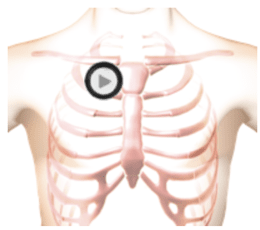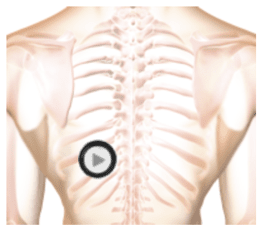Bronchial Breath Sound.
Introduction
Welcome to our website's bronchial breath sounds page. On this page we provide a definition of bronchial breath sounds, then compare bronchial sounds to vesicular sounds using audio recordings and text. Finally, there is a link to the training lessons available on this site.
Our bronchial lung sound lesson can be found in this course. Secondly, our reference index is designed to provide quick access to stridor sounds, with audio tracks, listening guides and waveforms. Use this link for quick reference to heart and lung sounds.
What Are Bronchial Breath Sounds?
Bronchial breath sounds are tubular, hollow sounds which are heard when auscultating over the large airways (e.g. second and third intercostal spaces). They will be louder and higher-pitched than vesicular breath sounds.
Listen
Listening Tips
These are hollow, tubular, lower pitched sounds that can be heard over the trachea in normal cases. Usually a distinct pause can be noticed between inspiration and expiration.
Bronchial Audio Playback


The patient was seated during auscultation.
Waveform
Compare To Vesicular


The patient was seated during auscultation.
Respiratory Sounds Reference Guide
Our auscultation reference guide provides quick access to this sound as well as many other adventitious sounds. Each sound is described also with an audio recording and waveform.Quick Links to Other Breath Sounds
While we have many breath sound lessons and quick references on this website. Please use the links below.
Bronchial Breath Sounds
Adventitious Breath Sounds
Adventitious Lung Sounds
Wheezing
Rhonchi
Fine and Coarse Crackles
Rales
Egophony
Auscultation Lung Sounds Audio
Related Lessons
| Basics of Lung Sounds
The goal of this basic course in lung sounds is to improve auscultation observational skills. We focus on describing important breath sounds and in providing recordings of each. Many students find that waveform tracings aid in learning lung sounds; we have included dynamic (moving cursor) waveforms with each lesson. The anatomy pages use illustrations to reveal an example of each lung sound (anatomy not yet available on smartphones). |
| 1 | Vesicular - Normal |
| 2 | Crackles - Fine (Rales) |
| 3 | Crackles - Coarse (Rales) |
| 4 | Wheeze |
| 5 | Rhonchi - Low Pitched Wheezes |
| 6 | Bronchial |
| 7 | Pleural Rubs |
| 8 | Bronchovesicular |
| Intermediate Lung Sounds
The goal of this intermediate course is to expand your observational skills when auscultating breath sounds. The course lessons include voiced sounds: bronchophony, egophony and whispered pectoriloquy. We also provide auscultation lessons on several types of wheezes, crackles and stridor. Each of these lung sound lessons includes audio, text and dynamic waveform. The anatomy pages use illustrations to reveal an example of each lung sound (anatomy not yet available on smartphones). |
| 1 | Vesicular - Diminished |
| 2 | Bronchophony - Healthy |
| 3 | Bronchophony - Abnormal |
| 4 | Egophony - e |
| 5 | Egophony - a |
| 6 | Whispered Pectoriloquy - Healthy |
| 7 | Whispered Pectoriloquy - Abnormal |
| 8 | Wheeze - Expiratory |
| 9 | Wheeze - Monophonic |
| 10 | Wheeze - Polyphonic |
| 11 | Crackles - Early Inspiratory (Rales) |
| 12 | Crackles - Late Inspiratory (Rales) |
| 13 | Stridor |
Authors and Reviewers
-
Heart sounds by Dr. Jonathan Keroes, MD and David Lieberman, Developer, Virtual Cardiac Patient.
- Lung sounds provided by Diane Wrigley, PA
-
Heart sounds mentorship by W. Proctor Harvey, MD>
- Reviewed by Dr. Barbara Erickson, PhD, RN, CCRN.
-
Last Update: 11/10/2022
Sources
-
Heart Sounds and Murmurs Across the Lifespan (with CD)
by Dr Barbara Ann Erickson
Publisher: Mosby
ISBN-10: 0323020453; ISBN-13: 978-0323020459 -
Heart Sounds and Murmurs: A Practical Guide with Audio CD-ROM 3rd Edition
Elsevier-Health Sciences Division
Barbara A. Erickson, PhD, RN, CCRN -
Heart and Lung Sounds Reference Guide
PracticalClinicalSkills.com -
Heart Sounds Made Easy with CD-ROM: (with CD-ROM) 2nd Edition
Anthony P. Salmon
ISBN-13: 978-0443069079 - NCBI Review of Heart Sounds and Murmurs: A Practical Guide
-
The Virtual Cardiac Patient: A Multimedia Guide to Heart Sounds And Murmurs
Jonathan Keroes, David Lieberman
Publisher: Lippincott Williams & Wilkin)
ISBN-10: 0781784425; ISBN-13: 978-0781784429 -
Ventricular Function Curves in the Exercising Dog
JONATHAN KEROES , ROGER R. ECKER , and ELLIOT RAPAPORT
Circulation Research, Vol. 25, No. 5 -
Electrocardiographic changes associated with ritodrine-induced maternal tachycardia and hypokalemia
American Journal of Obstetrics Gynecology, VOLUME 154, ISSUE 4, P921-923, APRIL 01, 1986
Susan K Hendricks, MD, Jonathan Keroes, MD, Michael Katz, MD -
A Multimedia Guide to Heart Sounds and Murmurs
January 2007 JAMA The Journal of the American Medical Association 297(2):217-218
DOI:10.1001/jama.297.2.217. M. Saleem Seyal, MD, Reviewer - Clinical Heart Disease
W Proctor Harvey, MD
Laennec Publishing; 1st edition (January 1, 2009)